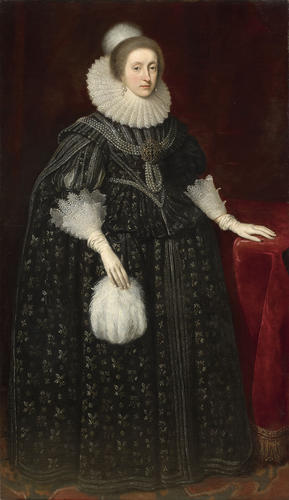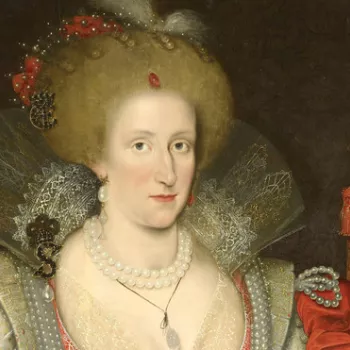Elizabeth, Queen of Bohemia (1596-1662) 1626-before 7 Mar 1627?
Oil on canvas | 196.4 x 114.4 cm (support, canvas/panel/stretcher external) | RCIN 400094
-
The daughter of James I, Elizabeth Stuart married Frederick V, Elector Palatine, in 1613 and took up residence at Heidelberg Castle, where a magnificent garden was created for her. In 1619 Frederick was offered the throne of Bohemia, where the couple reigned until their defeat at the Battle of the White Mountain in 1620. The brevity of their reign earned them the nicknames 'Winter King' and 'Winter Queen'. The couple spent their remaining years in exile in the Dutch Republic, though Queen Elizabeth returned to England for the last year of her life. The Hanoverian claim to the throne (and that of all subsequent British monarchs) derives from the Act of Settlement of 1701, which named the Electress Sophia of Hanover (1630-1714), Elizabeth of Bohemia's youngest daughter, as the most direct Protestant heir to the throne.
Charles I commissioned Mytens to paint this full-length portrait of his sister for a gallery of family portraits housed at Queen Henrietta Maria's London residence, Somerset House. Here the portrait would have hung alongside other full-length portraits of members of the Stuart family, some recent Tudor kings and several contemporary continental monarchs including Louis XIII of France and Philip III of Spain. A display such as this served to underline the dynastic bonds linking the crowns of Europe and to establish that the Stuarts were part of the inner circle.
The wide shape of the sitter's skirt reveals that she is wearing a farthingale, by this period a relatively out of date style generally only worn for formal Court occasions. The higher waistline however indicates a shift towards the more relaxed style of dressing which was becoming more common. Her bodice includes long pendant sleeves which hang behind her back. Around her neck is a ruff supported at the back of the neck, which matches cuffs formed of three layers of the same expensive lace. The simple hairstyle is accessorised with a feather hairpiece which matches the white feather fan and the sitter's hands are encased in soft gloves of doeskin or kid, which crumble gentle at the wrist. The white paint used for the gloves has become more translucent over time, revealing that the hands, with wrists wrapped with strings of pearls, were completed before the gloves were added. This was not the artist's common practice and perhaps indicates a change of mind by the artist or sitter. The fingers of the gloves extend some distance beyond the end of the fingertips in the fashionable manner - a lengthening effect enhanced by the use of embroidered lines of decoration along the fingers and extending back on the hand. This creates an elegant length to the fingers and also indicates that the wearer is exempt from practical jobs.
Catalogue entry partly adapted from The Royal Portrait, London, 2010Provenance
Painted for Charles I; sold for £20 to Edmund Harrison and others 23 October 1651 from the Cross Gallery at Somerset House (no 314); recovered at the Restoration and back in the Cross Gallery at Somerset House in 1710 (no 21)
-
Creator(s)
-
Medium and techniques
Oil on canvas
Measurements
196.4 x 114.4 cm (support, canvas/panel/stretcher external)
218.9 x 138.0 x 7.5 cm (frame, external)









